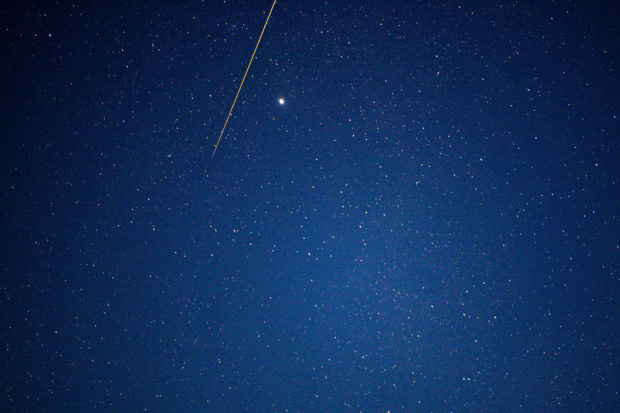Asteroid dust collected by Japan probe arrives on Earth

JAXA’s Hayabusa-2 probe’s sample drop to earth after landing on and gathering material from an asteroid some 300 million kilometres from Earth is seen from Coober Pedy in South Australia on December 6, 2020. – Call it a special delivery: after six years in space, Japan’s Hayabusa-2 probe is heading home, but only to drop off its rare asteroid samples before starting a new mission. (Photo by Morgan Sette / AFP)
TOKYO, Japan – In a streak of light across the night sky, samples collected from a distant asteroid arrived on Earth on Sunday after being dropped off by Japanese space probe Hayabusa-2.
Scientists hope the precious samples, which are expected to amount to no more than 0.1 grams of material, could help shed light on the origin of life and the formation of the universe.
The capsule carrying samples entered the atmosphere just before 2:30 am Japan time (1730 GMT Saturday), creating a shooting-star-like fireball as it entered Earth’s atmosphere.
“Six years and it has finally come back to Earth,” an official narrating a live broadcast of the arrival said, as images showed officials from Japan’s space agency JAXA cheering and pumping their fists in excitement.
The capsule separated from Hayabusa-2 on Saturday, when the refrigerator-sized space probe that launched into space in 2014 was 220,000 kilometres (137,000 miles) away from Earth.
Article continues after this advertisementIt landed in the southern Australian desert, where it will be recovered from an area spanning some 100 square kilometres, with search crews guided by beacons emitted as the capsule descended.
Article continues after this advertisementScientists at the Royal Australian Air Force’s (RAAF) Woomera Range Complex in South Australia closely monitored the capsule’s descent.
Samples in the capsule were collected from the asteroid Ryugu, some 300 million kilometres from Earth during two crucial phases of Hayabusa-2’s mission last year.
The probe collected both surface dust and pristine material from below the surface that was stirred up by firing an “impactor” into the asteroid.
The material collected from the asteroid is believed to be unchanged since the time the universe was formed.
Larger celestial bodies like Earth went through radical changes including heating and solidifying, changing the composition of the materials on their surface and below.
But “when it comes to smaller planets or smaller asteroids, these substances were not melted, and therefore it is believed that substances from 4.6 billion years ago are still there,” Hayabusa-2 mission manager Makoto Yoshikawa told reporters before the capsule arrived.
– Samples with organic material? –
Scientists are especially keen to discover whether the samples contain organic matter, which could have helped seed life on Earth.
“We still don’t know the origin of life on Earth and through this Hayabusa-2 mission, if we are able to study and understand these organic materials from Ryugu, it could be that these organic materials were the source of life on Earth,” Yoshikawa said.
Once the samples are recovered, they will be processed in Australia and then flown back to Japan.
Half the material will be shared between JAXA, US space agency NASA and other international organisations, and the rest kept for future study as advances are made in analytic technology.
– More tasks for Hayabusa-2 –
The work isn’t over for Hayabusa-2, which was launched in December 2014.
The probe will now begin an extended mission targeting two new asteroids.
Hayabusa-2 will complete a series of orbits around the sun for around six years before approaching the first of its target asteroids — named 2001 CC21 — in July 2026.
The probe won’t get that close, but scientists hope it will be able to photograph it and that the fly-by will help develop knowledge about how to protect Earth against asteroid impact.
Hayabusa-2 will then head towards its main target, 1998 KY26, a ball-shaped asteroid with a diameter of just 30 metres. When the probe arrives at the asteroid in July 2031, it will be approximately 300 million kilometres from Earth.
It will observe and photograph the asteroid, no easy task given that it is spinning rapidly, rotating on its axis about every 10 minutes.
But Hayabusa-2 is unlikely to land and collect samples, as it probably won’t have enough fuel to return them to Earth.